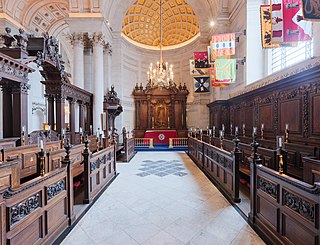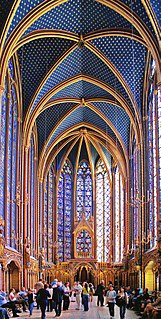| Notre Dame du Haut | |
|---|---|
 | |
| Religion | |
| Affiliation | Roman Catholic Church |
| Ecclesiastical or organizational status | Pilgrimage Chapel |
| Year consecrated | 25 June 1955 |
| Location | |
| Location | Ronchamp, Haute-Saône, France |
| Geographic coordinates | 47°42′16.37″N6°37′14.08″E / 47.7045472°N 6.6205778°E Coordinates: 47°42′16.37″N6°37′14.08″E / 47.7045472°N 6.6205778°E |
| Architecture | |
| Architect(s) | Le Corbusier |
| Type | church |
| Style | Modern |
| Groundbreaking | 1953 |
| Completed | 1955 |
| Materials | Concrete |
| Website | |
| www | |
| Official name | Chapelle Notre-Dame-du-Haut de Ronchamp |
| Part of | The Architectural Work of Le Corbusier, an Outstanding Contribution to the Modern Movement |
| Criteria | Cultural: (i), (ii), (vi) |
| Reference | 1321-012 |
| Inscription | 2016 (40th Session) |
| Area | 2.734 ha (0.01056 sq mi) |
| Buffer zone | 239.661 ha (0.92534 sq mi) |
| Official name | Chapelle Notre-Dame-du-Haut |
| Designated | 1967 |
| Reference no. | PA00102263 [1] |
| Denomination | Chapelle |
Notre Dame du Haut (English: Our Lady of the Heights; full name in French : Chapelle Notre-Dame-du-Haut de Ronchamp) is a Roman Catholic chapel in Ronchamp, France. Built in 1955, it is one of the finest examples of the architecture of Franco-Swiss architect Le Corbusier. The chapel is a working religious building and is under the guardianship of the private foundation Association de l’Œuvre de Notre-Dame du Haut. [2] It attracts 80,000 visitors each year. [2]

French is a Romance language of the Indo-European family. It descended from the Vulgar Latin of the Roman Empire, as did all Romance languages. French evolved from Gallo-Romance, the spoken Latin in Gaul, and more specifically in Northern Gaul. Its closest relatives are the other langues d'oïl—languages historically spoken in northern France and in southern Belgium, which French (Francien) has largely supplanted. French was also influenced by native Celtic languages of Northern Roman Gaul like Gallia Belgica and by the (Germanic) Frankish language of the post-Roman Frankish invaders. Today, owing to France's past overseas expansion, there are numerous French-based creole languages, most notably Haitian Creole. A French-speaking person or nation may be referred to as Francophone in both English and French.

A chapel is a Christian place of prayer and worship that is usually relatively small, and is distinguished from a church. The term has several senses. Firstly, smaller spaces inside a church that have their own altar are often called chapels; the Lady Chapel is a common type of these. Secondly, a chapel is a place of worship, sometimes non-denominational, that is part of a building or complex with some other main purpose, such as a school, college, hospital, palace or large aristocratic house, castle, barracks, prison, funeral home, cemetery, airport, or a military or commercial ship. Thirdly, chapels are small places of worship, built as satellite sites by a church or monastery, for example in remote areas; these are often called a chapel of ease. A feature of all these types is that often no clergy were permanently resident or specifically attached to the chapel. Finally, for historical reasons, chapel is also often the term used for independent or nonconformist places of worship in Great Britain—outside the established church, even where in practice they operate as a parish church.

Ronchamp is a commune in the Haute-Saône department in the region of Bourgogne-Franche-Comté in eastern France.

























